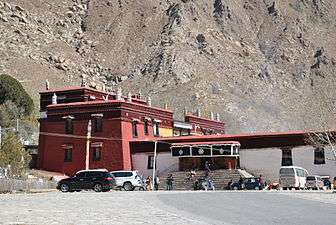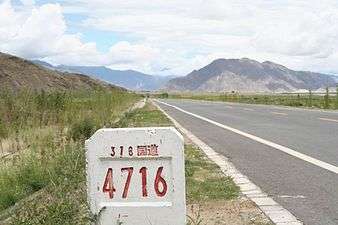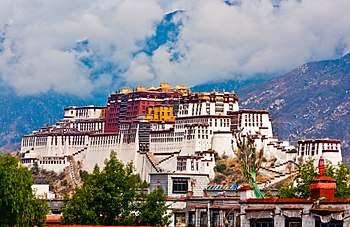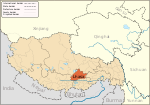Doilungdêqên District
Doilungdêqên District is a district in Lhasa, north-west of the main center of Chengguan, Tibet Autonomous Region. It is largely agricultural or pastoral, but contains the western suburbs of the city of Lhasa. The Duilong River runs southeast through the district to the Lhasa River. A prehistoric site appears to be 3600–3000 years old. The district is home to the Tsurphu Monastery (1189) and the 17th century Nechung monastery.
Doilungdêqên 堆龙德庆区 • སྟོད་ལུང་བདེ་ཆེན་ཆུས། | |
|---|---|
District | |
 New construction in Liuwu New Area | |

| |
 Location of Doilungdêqên within Tibet Autonomous Region | |
| Coordinates: 29°39′N 91°00′E | |
| Country | People's Republic of China |
| Autonomous region | Tibet |
| Prefecture-level city | Lhasa |
| Area | |
| • Total | 2,682 km2 (1,036 sq mi) |
| Time zone | UTC+8 (China Standard) |
| Doilungdêqên District | |||||||
|---|---|---|---|---|---|---|---|
| Chinese name | |||||||
| Simplified Chinese | 堆龙德庆区 | ||||||
| Traditional Chinese | 堆龍德慶區 | ||||||
| |||||||
| Tibetan name | |||||||
| Tibetan | སྟོད་ལུང་བདེ་ཆེན་ཆུས། | ||||||
| |||||||
Topography
Doilungdêgên is said to mean "valley of bliss" in Tibetan.[1][lower-alpha 1] The district is located in south-central Tibet. It contains the western suburbs of the city of Lhasa, capital of the Tibet Autonomous Region, which begin about 12 kilometres (7.5 mi) from the city center. It covers an area of 2,704 square kilometers, with 94,969 acres of farmland.[1]
The district borders on the north Tibet grasslands in the northwest. The valley of the Duilong River leads south to the Lhasa River, and is contained by two ridges of the Nianqing Tanggula Mountains. The Duilong is 95 kilometres (59 mi) in length, and has hydroelectrical power generation capacity of 4,000 KW. In the south the district occupies part of the south bank of the Lhasa River. There are about sixty rivers and streams in total.[3] The district has an average elevation of 4,000 metres (13,000 ft), with a highest elevation of 5,500 metres (18,000 ft) and a lowest point at 3,640 metres (11,940 ft).[1]
Environment
There are about 120 frost-free days annually.[1] Annual mean temperature is 7 °C (45 °F), with temperatures in January falling below −10 °C (14 °F) Annual precipitation is about 440 millimetres (17 in), with autumn rainfall of 310 millimetres (12 in). The district is agriculturally rich and was used by the Tibetan kings as a source of food for Lhasa.[3] Wildlife includes roe deer, otter, brown bear, leopard, black-necked crane, Chinese caterpillar fungus, Fritillaria and snow lotus.[1] Military personnel have been involved in efforts to protect and improve the environment, including replanting programs.[4]
Demographics
In 1992 there were 33,581 people in 6,500 households, with 94.28% of the people engaged in farming. About 90% of the people were ethnic Tibetan, with most people of other ethnicity living in Donggar.[3] The 2000 census gave a total population of 40,543 people: Donggar 9,359, Naiqiong 7,838, Dechen 5,731 people, Mar 4,458, Gurung 5,664, Yabda 3,664, Liuwu 3,829. The total population as of the end of 2007 was 45,551 people.[5] The first drug rehabilitation center in Tibet was being constructed in Duilongdeqing District in 2009. It would provide physiological rehabilitation, psychological therapy and job training for up to 150 drug addicts.[6]
Subdistricts and townships

Duilongdeqing County was founded in September 1959, and in February 1960 expanded to include the western suburbs of Lhasa.[7] The district has been rapidly urbanizing. In January 2015 the former county government was preparing to upgrade Doilungdêqên into Lhasa's second urban district.[8] The county was finally upgraded into a district on 13 October 2015. The district has jurisdiction over four subdistricts and three townships, covering thirty-five administrative villages. The seat of government is in the town of Donggar.[1] This is just 14 kilometres (8.7 mi) from downtown Lhasa.[3] Divisions are:[1]
- Donggar Subdistrict གདོང་དཀར་ 东嘎街道
- Liuwu Subdistrict (Niu Subdistrict) སྣེའུ་ 柳梧街道
- Naiqung Subdistrict གནས་ཆུང་, 乃琼街道
- Yabda Subdistrict ཡབ་མདའ་, 羊达街道
- Dêqên Township བདེ་ཆེན་, 德庆乡
- Mar Township དམར་, 马乡
- Gurum Township རྒུ་རུམ་, 古荣乡
Economy
Until the 1980s almost all of the rural residents farmed and raised livestock. After reform and an open policy were adopted, growing numbers began to move into industry, construction, transport, commerce and more skilled occupations.[9] In the mid-1980s many local factories and processing plants were built at the village level, but most of them failed to survive. The construction force grew in the 1980s to meet demand for "43 engineering projects" in Lhasa, and construction remained an important source of employment in the late 1990s. At the same time, inefficient traditional farming and herding practices were replaced by more modern techniques.[10]
The economy is still dominated by agriculture. Vegetable production is an important industry in Donggar.[7] Other agricultural products include wheat, spring wheat, barley, peas, beans and potatoes. Livestock includes zaks, sheep, goats and poultry. The main mineral resources are coal, iron, clay, lead and zinc.[1]
Communications
The Qinghai–Tibet Railway runs through the district beside the Qinghai–Tibet Highway (China National Highway 318) from northeast to southwest. The district is crossed by China National Highway 109 in the south.[5] 47 other roads have a total length of 270 kilometres (170 mi).[7] Lhasa railway station is in Liuwu township.[11] The terminus of the Qinghai–Tibet line, it is over 3,600 metres (11,800 ft) above sea level, and is its largest passenger transport station. It includes a clinic with oxygen treatment facilities. The station uses solar energy for heating.[12]
Landmarks
The best-known landmark is Tsurphu Monastery, built in 1189 and treated as a regional cultural relic reserve.[2] The monastery was founded by Düsum Khyenpa, 1st Karmapa Lama, founder of Karma Kagyu school. It is the main Kagyu temple.[7] The Nechung Monastery, former home of the Nechung Oracle, is located in Naiquong township.[13] Nechung was built by the 5th Dalai Lama (1617–82).[14] Nechung was almost completely destroyed during the Cultural Revolution but has been largely restored. There is a huge new statue of Guru Rinpoche (Padmasambhava) on the second floor.[15] There are also hot springs that are said to have various curative powers.[7]
A prehistoric site was found in 2007 in a location where sand was being quarried at Chang Village in Yabda Township at 3,642 metres (11,949 ft) above sea level, about 18 kilometres (11 mi) west of Lhasa. The site was protected pending formal excavation. A layer about 15 to 30 centimetres (5.9 to 11.8 in) thick contained charcoal, ash, animal bones, pottery and stone tools. The site appears to be 3600–3000 years old.[16]
.jpg) Tsurpu Monastery
Tsurpu Monastery Landscape near Tsurphu Monastery
Landscape near Tsurphu Monastery Nechung monastery to the west of downtown Lhasa
Nechung monastery to the west of downtown Lhasa China National Highway 318 between Doilungdêqên and Qüxü County
China National Highway 318 between Doilungdêqên and Qüxü County
See also
- Liuwu New Area
References
- Lhasa Duilongdeqing County Profile.
- Lin 2014.
- Ge Le & Li Tao 1996, p. 35.
- Guo 2014.
- Duilongdeqing County, Administrative divisions.
- First drug rehabilitation center in Tibet ... 2009.
- Lhasa Duilongdeqing County Introduction.
- Ling 2015.
- Ge Le & Li Tao 1996, p. 36.
- Ge Le & Li Tao 1996, p. 37.
- Lhasa Railway Station, Tripadvisor.
- Lhasa Railway Station Duilongdeqing County.
- Foster et al. 2012, p. 787.
- LaRocca 2006, p. 28.
- Mayhew & Kohn 2005, p. 22.
- Wangdu 2008.
| Wikimedia Commons has media related to Doilungdêqên District. |
Sources
- "Duilongdeqing County". Administrative divisions Network (in Chinese). Retrieved 2015-02-10.
- "First drug rehabilitation center in Tibet to be constructed in Duilongdeqing County". China Tiber Online. 2009-06-29. Retrieved 2015-02-10.
- Foster, Simon; Lee, Candice; Lin-Liu, Jen; Reiber, Beth; Tini Tran; Lee Wing-sze; Christopher D. Winnan (2012-03-12). Frommer's China. John Wiley & Sons. ISBN 978-1-118-23677-2. Retrieved 2015-02-10.CS1 maint: ref=harv (link)
- Ge Le; Li Tao (1996). "Rural Urbanization in China's Tibetan Region: Duilongdeq County as a Typical Example" (PDF). Chinese Sociology and Anthropology. 28 (4). Retrieved 2015-02-10.CS1 maint: ref=harv (link)
- Guo, Feng Peng (2014-07-19). "Tibet Duilongdeqing county total civilian ecological vanguard striving to protect the mountains". Retrieved 2015-02-10.CS1 maint: ref=harv (link)
- LaRocca, Donald J. (2006-01-01). Warriors of the Himalayas: Rediscovering the Arms and Armor of Tibet. Metropolitan Museum of Art. ISBN 978-1-58839-180-3. Retrieved 2015-02-10.CS1 maint: ref=harv (link)
- "Lhasa Duilongdeqing County Introduction". Lhasa Tourism (in Chinese). Retrieved 2015-02-10.
- "Lhasa Duilongdeqing County Profile". Chinese Government Network (in Chinese). Archived from the original on 2015-02-09. Retrieved 2015-02-09.
- "Lhasa Railway Station". Tripadvisor. Retrieved 2015-02-10.
- "Lhasa Railway Station Duilongdeqing County". China Comfort Travel. Archived from the original on 2015-02-10. Retrieved 2015-02-10.
- Lin, Tony (2014-05-27). "Duilongdeqing County, Lhasa". Tibet Travel. Retrieved 2015-02-10.CS1 maint: ref=harv (link)
- Ling, Yang Yunqin (2015-01-23). "Lhasa Duilongdeqing County Magistrate: actively preparing..." People's Daily (in Chinese). Retrieved 2015-02-10.CS1 maint: ref=harv (link)
- Mayhew, Bradley; Kohn, Michael (2005). Tibet. Lonely Planet Publications. ISBN 1-74059-523-8.CS1 maint: ref=harv (link)
- Wangdu, Owen (2008-03-06). "Tibet Duilongdeqing County Prehistoric Site Discovered". Retrieved 2015-02-10.CS1 maint: ref=harv (link)

